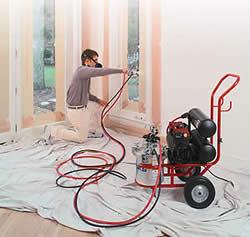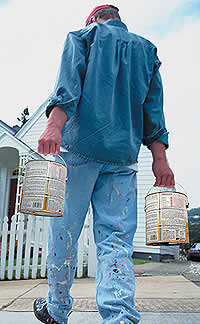
Primers Priming interior woodwork, trim and crown molding
Using a primer will strengthen the bond between the substrate and top coat, seal the substrate surface, improve top coat gloss, and more.
by Robert Simpson
in the paint contractor’s arsenal. Often more attention is paid to how glossy the final top coat should be than to the preparation necessary to assure the longevity of the finish. Using a primer will strengthen the bond between the substrate and top coat, seal the substrate surface, improve top coat gloss, enhance impact resistance, and reduce costly callbacks when high-traffic surfaces begin to wear.
Anyone who has been to their paint supplier lately knows that there are an overwhelming number of primer products to choose from. One of the complicating factors in making the choice is terminology. Primers and undercoats are words almost always used interchangeably in the paint business.  Generally, undercoating is a broad term that includes the category of primers. A primer’s specific purpose is to provide a strong link between the top coat and the substrate. Primers are generally products that have high pigment content or high pigment volume concentration (PVC) and serve to form a firm foundation for the top coat. Primers can be alkyd or latex formulations, and are used on interior and exterior applications. If they are properly applied, using primers instead of other undercoats ensures the finish coat will adhere and last longer. Generally, undercoating is a broad term that includes the category of primers. A primer’s specific purpose is to provide a strong link between the top coat and the substrate. Primers are generally products that have high pigment content or high pigment volume concentration (PVC) and serve to form a firm foundation for the top coat. Primers can be alkyd or latex formulations, and are used on interior and exterior applications. If they are properly applied, using primers instead of other undercoats ensures the finish coat will adhere and last longer.
Selecting the appropriate primer for high-traffic-area trims and moldings is essential to assuring the longevity of your finish. Painters often fail to consider primers with any real seriousness when painting crown moldings and decorative trim. Many prefer to use an undercoat that will supplement the enamel topcoat’s thickness rather than a primer for establishing a permanent link between the substrate and top coat. The right primer selection depends in large part on its composition. There are three types of primers — water-based (acrylic), oil-based (alkyd) and white pigmented shellac. Some primers are more appropriate than others for sealing, bonding or leveling requirements. Sealing primers seal, lock out and hide stains, graffiti, tannin bleed and damage from other trades. These primers are ideal for delivering the best appearance of flats and enamels on wood doors, trim, crown moldings and stair banisters. Primers in this category are generally 100 percent acrylic. Most effectively seal out common stains found in all architectural settings. Perfect for rehabilitation work, this category tends to ensure a smooth uniform topcoat. Bonding primers tightly anchor topcoats to slick and hard-to-paint surfaces, promoting durable adhesion and reducing prep time. These latex primers are best used under flat and enamel coatings on such substrates as plastic trim and molding, green board, varnished or enameled surfaces. Leveling primers provide excellent hold to ensure uniformity and gloss on multiple substrates of varying porosity. This category is generally used under enamels or flats on walls, doors, drywall, plaster, and on wood to eliminate dull spots, or shiners. The 100 percent acrylic latex versions of these primers tend to be ideal for all-around, general use while fast drying action allows them to be sanded as soon as two hours after application. For those more traditionally bound, oil-based primers are an alternative to guarantee that enamel topcoats develop their full gloss on interior wood, especially on elaborate or detailed crown molding, staircase banisters and doors. Proper ventilation is critical when using these products. Various needs call for various approaches. When the painter needs penetration into the substrate, selecting a lower PVC (Pigment Volume Concentration) first coat, such as a sealer or primer/sealer will be helpful. Higher PVC products yield stronger hiding qualities. Stain sealing is a job for lower PVC or higher binder content, and possibly specific additives to help block or tie up the stain. Once the correct primer has been selected, following proper preparation techniques will assure the maximum bond between the substrate and the top coat. The primer film needs to be applied to a clean, stable surface so that it can form the correct film. If the air and surface temperature are too hot, the solvents or water will evaporate too quickly, preventing good film formation. If the temperature of the air and surface are too cold, the film may not form correctly — for best performance an approximate room temperature of 72 degrees is required.
Other common problems are over-thinning by adding a solvent, applying too thin or too heavy a coat and recoating too quickly. Follow the manufacturer’s label recommendations for application rates and for thinning concentrations. Always provide ample time for the surface to completely dry before applying a topcoat. Today’s primers have come a long way, both in variety and performance. There are several good all-purpose primers as well as new primers developed as solutions for hard-to-paint substrates. It is recommended before beginning any job to consult with a local supplier about correct primer choice to deliver a topcoat with the ultimate in appearance, value and longevity. By guaranteeing a secure bond between the substrate and the top coat, the use of primers on trim, crown moldings and interior woodwork will result in fewer callbacks and happier customers. 
|

